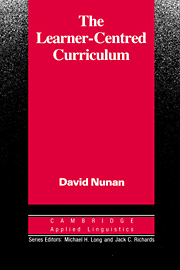Book contents
- Frontmatter
- Contents
- Series Editors' Preface
- Preface
- 1 Introduction
- 2 Curriculum Processes
- 3 Learner-Centred Curriculum Development
- 4 Pre-Course Planning Procedures
- 5 Planning Content
- 6 Methodology
- 7 Resources for a Learner-Centred Curriculum
- 8 Assessment and Evaluation
- 9 Evaluation and Professional Development
- 10 The Teacher as Curriculum Developer
- References
- Appendix
- Subject Index
- Author Index
- Frontmatter
- Contents
- Series Editors' Preface
- Preface
- 1 Introduction
- 2 Curriculum Processes
- 3 Learner-Centred Curriculum Development
- 4 Pre-Course Planning Procedures
- 5 Planning Content
- 6 Methodology
- 7 Resources for a Learner-Centred Curriculum
- 8 Assessment and Evaluation
- 9 Evaluation and Professional Development
- 10 The Teacher as Curriculum Developer
- References
- Appendix
- Subject Index
- Author Index
Summary
Introduction
Traditional approaches to language teaching have tended to separate considerations of syllabus design from methodology. Broadly speaking, syllabuses specify the ‘what’ of teaching whereas methodology specifies the ‘how’. Applied linguists, particularly those working within the British and European tradition, have tended to focus on syllabus design, whereas teachers, who are more concerned with the day-to-day aspects of teaching, have tended to be more interested in methodological considerations.
In recent times, the shortcomings of this lack of integration have become apparent, and there have been calls for a more integrated approach to language curriculum development and course design by applied linguists such as Richards (1984), Long (1985) and Nunan (1985a). In his proposal for an integrated approach, Nunan suggests that:
Traditional models tend to restrict themselves to objectives specification, content selection, grading and evaluation. It is felt by some syllabus designers that there ought to be a rigid separation between syllabus design and methodology, in other words, that considerations of what to teach ought to be kept separate from how to teach. Such a separation has led in the past to such aberrations as the teaching of courses whose input was specified in functional-notional terms through an audiolingual methodology.
In the model proposed here, all the elements are in interaction and each may influence the other. Objectives may be modified, altered or added to during the teaching-learning process. Decisions about what goes on in the classroom will be influenced, not only by pre-specified objectives, materials and activities, but also by needs, constraints (what is feasible, say, in the learning mode and environment) and by the evaluation feedback which emerges during the course itself.
(Nunan 1985a:2–3)- Type
- Chapter
- Information
- The Learner-Centred CurriculumA Study in Second Language Teaching, pp. 76 - 97Publisher: Cambridge University PressPrint publication year: 1988



